域外案例
缅甸古代都城空间形态演化及规划特征研究
摘要: 缅甸古代都城空间形态演化及规划特征研究本文摘编自《城市规划》【中图分类号】TU984.337【文献标识码】A【doi】10.11819/cpr20251605a【作者简介】江泓(1979-),男,博士,东南大学建筑学院副院长,副教授,城市与建筑遗产保护教育部重点实验室(东南大学)副主任,中国城市规划学会城市规划历史与理论分会秘书长,本文通信作者。周妍(1996-),女,东南大 ...
缅甸古代都城空间形态演化及规划特征研究
本文摘编自《城市规划》
【中图分类号】TU984.337
【文献标识码】A
【doi】10.11819/cpr20251605a
【作者简介】
江泓(1979-),男,博士,东南大学建筑学院副院长,副教授,城市与建筑遗产保护教育部重点实验室(东南大学)副主任,中国城市规划学会城市规划历史与理论分会秘书长,本文通信作者。
周妍(1996-),女,东南大学建筑学院博士研究生。
* 国家自然科学基金项目“基于多源遥感数据的中南半岛历史都城形态特征、类型谱系与遗产价值研究”(52078116)资助。
“任何首都在居住在其内外的人民和境外民族来看,都是它所统治的世界的一个缩影。”
——阿诺德·汤因比
缅甸历史文化资源丰富,其历史都城在不同阶段、地域、文化的影响下呈现出独特而多元的城市形态,是亚洲文化遗产体系的重要组成部分。文章基于对都城空间及其形成背景的历史回顾,分析了缅甸古代都城的发展阶段和空间形态,系统总结了都城形态的总体演化特征和规划内涵。研究成果深化了对缅甸古代都城空间及其规划内涵的整体认知,为揭示遗产价值和古城有效保护提供了科学依据和研究基础。
缅甸古代都城建设背景与总体分布
从地理分布来看,缅甸古代都城皆在通江达海处分布,伊洛瓦底江、勃固河、卡叻丹河等多个大河流域都曾见证着部落与王朝的兴衰。而伊洛瓦底江之于缅甸,如同尼罗河之于埃及,其重要性不言而喻。由此带来的上下游南北对峙情形,也成为缅甸历史中不断上演的主题。地方民族政权在各自区域经营发展,有频繁的建都行为,形成了中部河谷平原、南部沿海地区与西部沿海地区这三大政权中心分布区域。
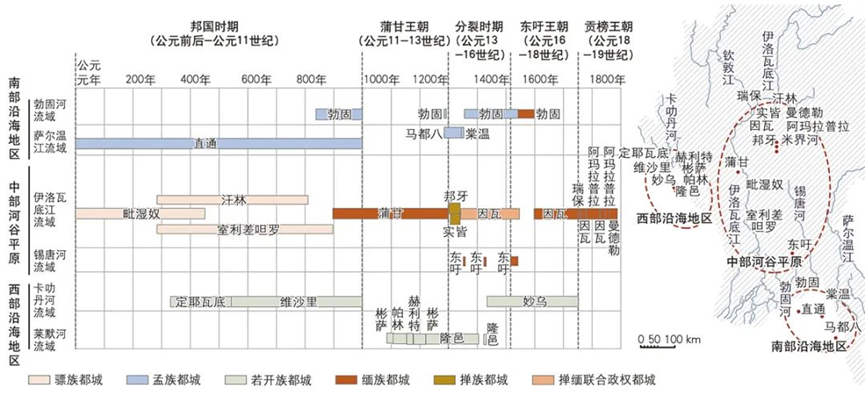
图1 缅甸古代都城时空分布
Figure 1 Spatial and temporal distribution of Myanmar ancient capitals
缅甸古代都城空间形态及发展阶段
缅甸古代都城空间形态经历了“初始萌芽期”(公元前后至公元10世纪)、“过渡发展期”(公元11-16世纪)与“稳定成熟期”(稳定成熟期:公元16-19世纪)的发展阶段。
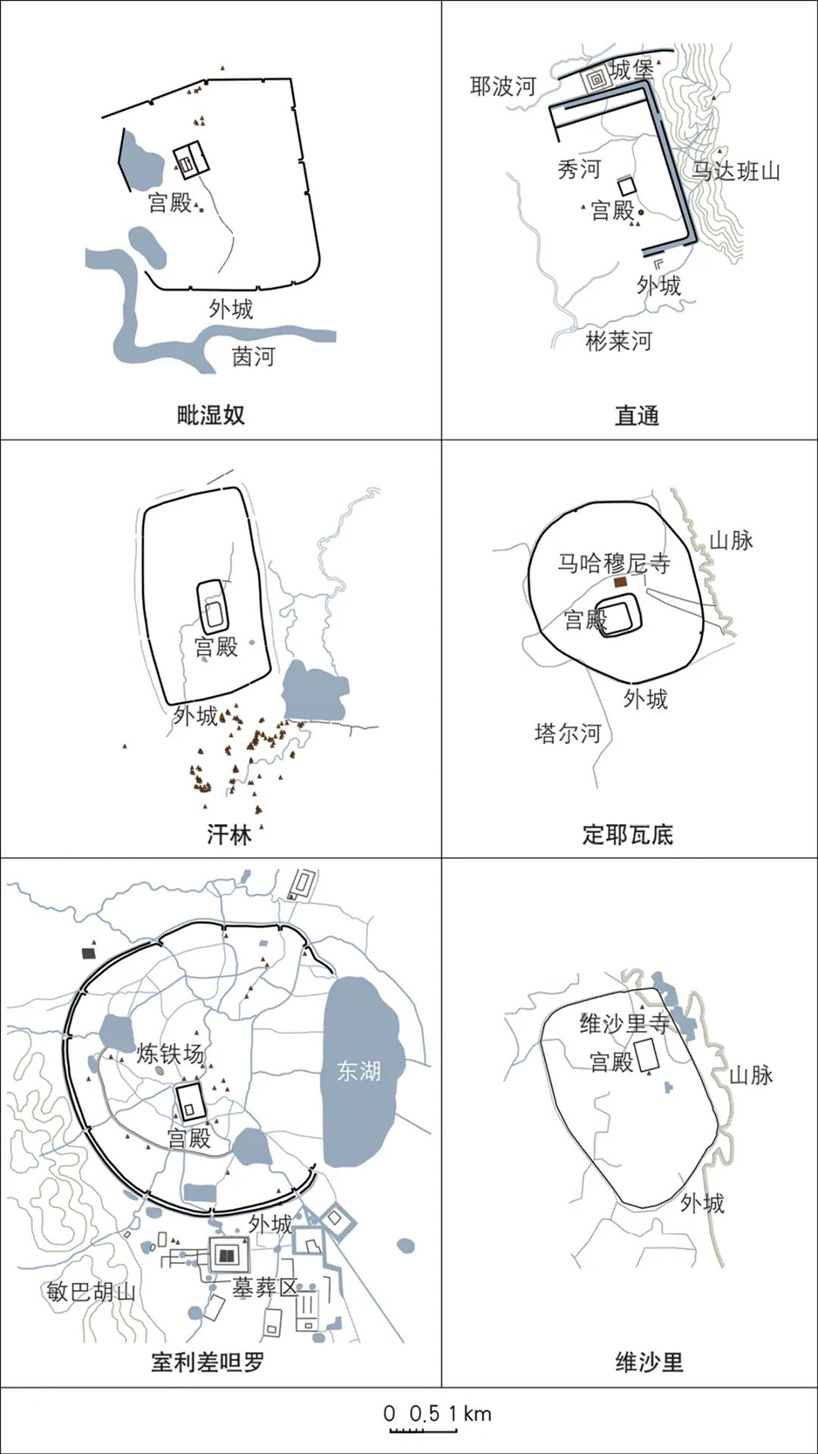
图2 初始萌芽期的缅甸古代都城空间形态
Figure 2 Spatial forms of Myanmar ancient capitals in the initial period
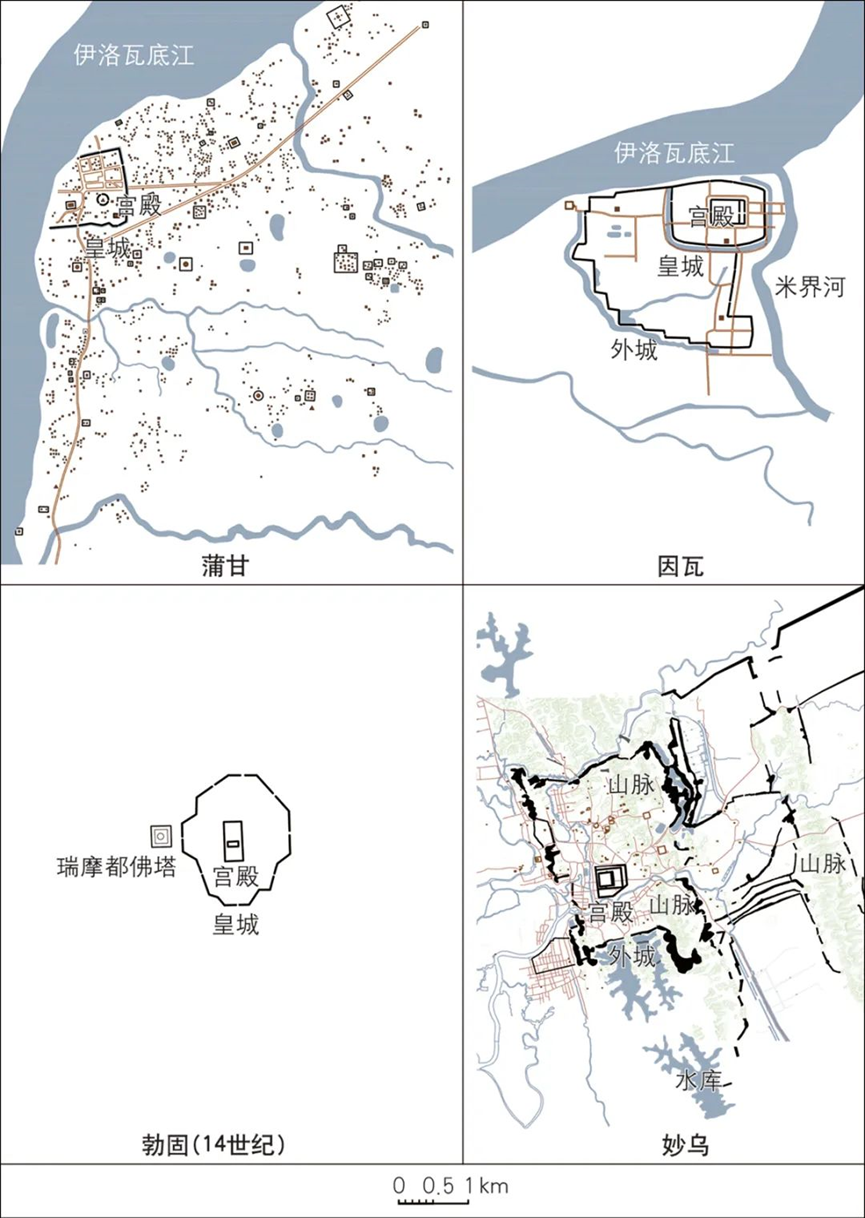
图3 过渡发展期的缅甸古代都城空间形态
Figure 3 Spatial forms of Myanmar ancient capitals in transitional and developing period
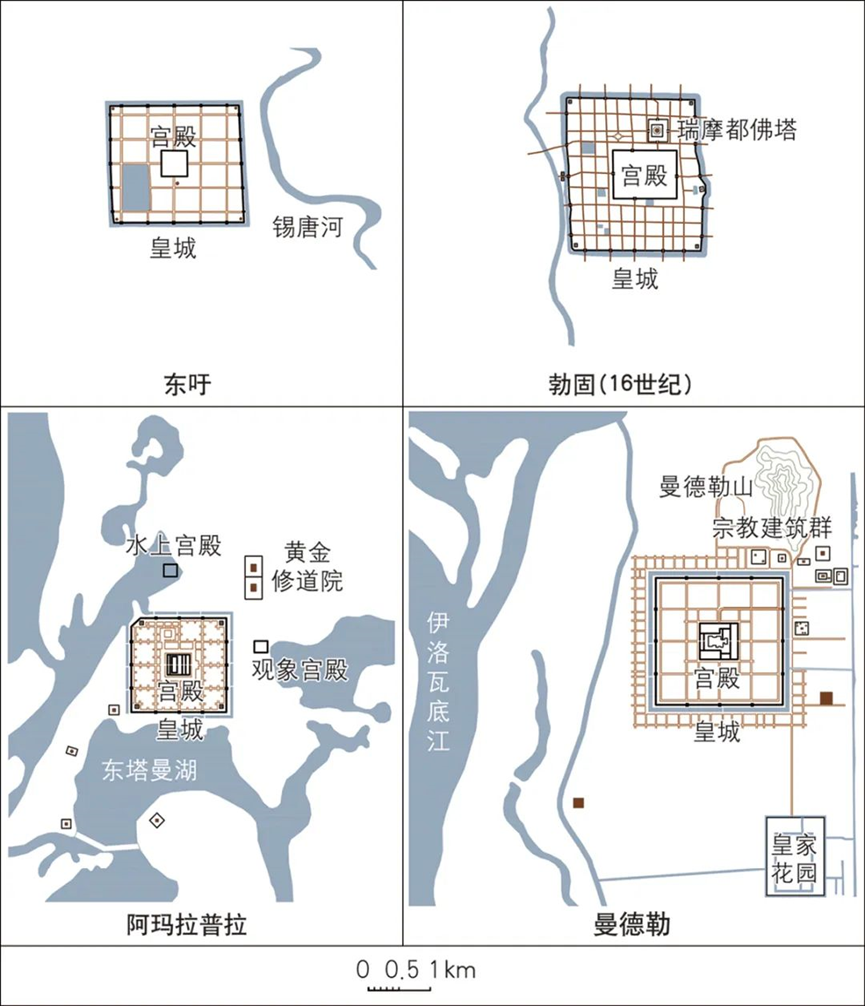
图4 稳定成熟期的缅甸古代都城空间形态
Figure 4 Spatial forms of Myanmar ancient capitals in the mature period
缅缅甸古代都城演化特征与规划内涵
缅甸都城具有显著的自身特色,呈现出规划思想多源融合、都城选址向心集中、功能体系单一发展和形式布局规整成型的演化特征。其空间形态演化折射了政权结构和治理模式的发展历程,既非嫁接式的一蹴而就,又非断裂式的多头并进,而是在多元民族的背景下,本土文化吸收融合多元文明成果进行的空间创造,体现出了清晰的发展轨迹和明确的演化阶段。
都城见证了一个国家文明的发展,而都城规划是国家治理的重要手段,缅甸古代都城成为理解缅甸历史文化的重要窗口。缅甸古代都城承接了多元文明的影响,是东南亚历史城市体系中特点鲜明的一支,也是亚洲多元文化的重要例证,其空间特色和遗产价值应在未来的保护和发展中得到充分认识。
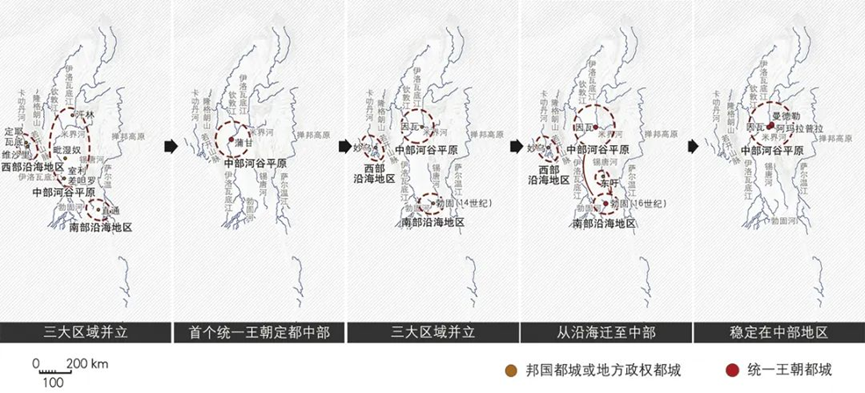
图5 缅甸古代都城分布演变
Figure 5 Evolution of the distribution of ancient Myanmar’s capitals
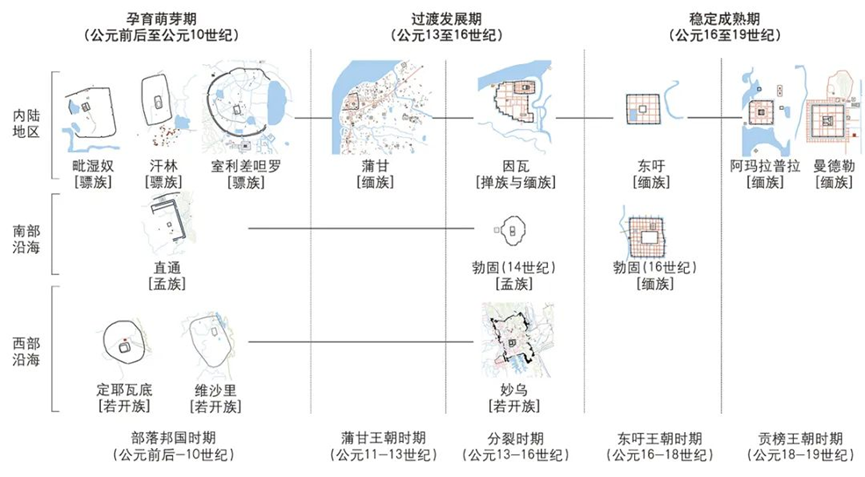
图6 缅甸古代都城空间演化示意
Figure 6 Spatial evolution of Myanmar’s ancient capitals
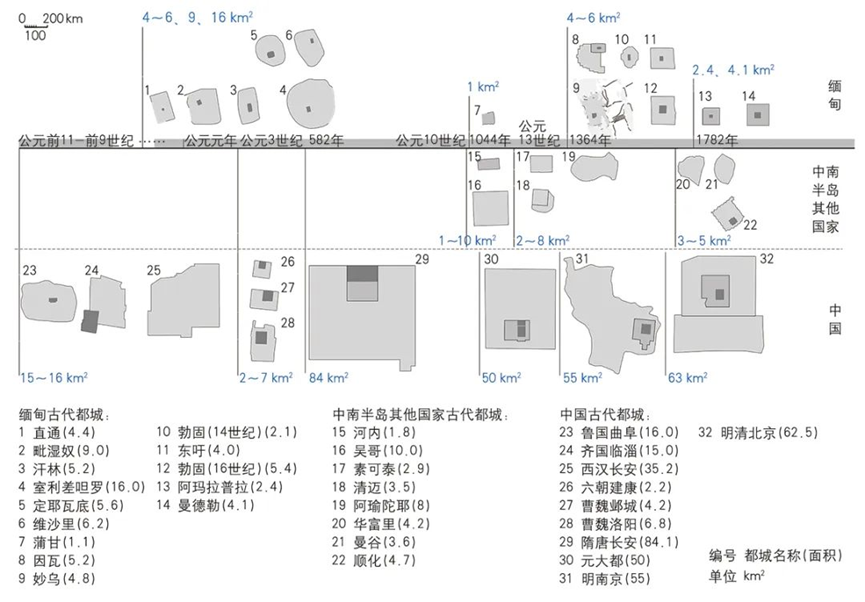
图7 古代缅甸与周边国家都城对照
Figure 7 Comparison of Myanmar ancient capitals with those of the surrounding countries
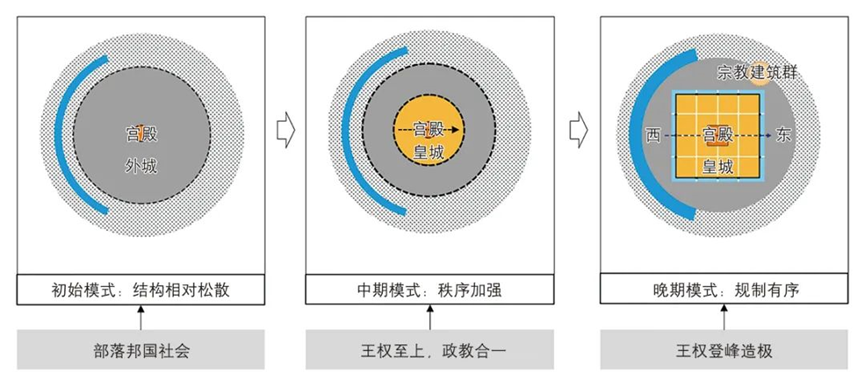
图8 缅甸古代都城空间形态演变模式
Figure 8 Evolution patterns of spatial urban forms of Myanmar’s ancient capital

Article
RESEARCH ON URBAN FORM EVOLUTION AND PLANNING CHARACTERISTICS OF ANCIENT CAPITALS IN MYANMAR
Myanmar is rich in historical and cultural resources. Its historical capitals, shaped by different periods, regions, and cultural influences, present unique and diverse spatial forms, constituting an important part of the Asian cultural heritage system. This study conducts a historical review of the spatial development of these capitals and analyzes their formation context. It examines the development stages and spatial patterns of Myanmar’s ancient capitals, systematically summarizing their overall evolutionary characteristics and planning implications. The research findings contribute to a more comprehensive understanding of the spatial characteristics and planning implications of Myanmar’s ancient capitals, providing a scientific basis and research foundation for revealing their heritage value and ensuring effective protection of these ancient cities.
Background and Spatial Distribution of Ancient Capitals in Myanmar
In terms of geographical distribution, ancient capitals in Myanmar were all located along river routes with access to the sea. Major river basins such as the Irrawaddy, Bago, and Kaladan have witnessed the rise and fall of various tribes and dynasties. The Irrawaddy River holds a significance for Myanmar comparable to that of the Nile for Egypt—its importance is self-evident. The resulting north-south division between upstream and downstream regions became a recurring theme in Myanmar’s history. Local ethnic polities developed within their respective territories and frequently established new capitals, eventually forming three major centers of political power: the central river valley plains, the southern coastal region, and the western coastal region.
The Urban Forms and Development Stages of Ancient Capitals in Myanmar
The spatial forms of Myanmar’s ancient capitals have undergone three distinct phases: the “initial period” (Circa AD-the 11th century AD), the “transitional and developing period” (the 11th -16th century AD), and the “mature period” (the 16th -19th century AD).
The Evolution Characteristics and Planning implications of Ancient Capitals in Myanmar
The capital cities of Myanmar possess distinct characteristics of their own. This evolutionary process demonstrates a fusion of planning ideas from various sources, a trend toward centralization of city sites, a simple development of functional systems, and a gradual shaping of physical layouts in a more regular manner. These patterns reflect the evolution of Myanmar’s ancient regime structure and governance model. The evolution of their spatial forms reflects the historical development of political structures and governance models. This process was neither a rapid transplantation nor a fragmented, parallel progression; rather, it was a creative spatial endeavor rooted in indigenous culture that absorbed and integrated diverse civilizational influences within a multi-ethnic context. The result is a clear developmental trajectory with identifiable evolutionary stages.
Capitals bear witness to the development of a nation's civilization, and capital planning has long served as a key instrument of national governance. Ancient capitals of Myanmar thus offer a vital lens through which to understand the country's historical and cultural heritage. Influenced by a variety of civilizations, these cities represent a distinctive branch within the system of Southeast Asian historical cities and serve as compelling examples of Asia’s cultural diversity. Their spatial characteristics and heritage value deserve full recognition in future conservation and development efforts.
END
图文来源:
江泓、周妍,《缅甸古代都城空间形态演化及规划特征研究》
编辑排版:陈君
审核:汪艳
审定:董卫

扫码关注
亚洲遗产管理学会
Asian Academy for
Heritage Management
